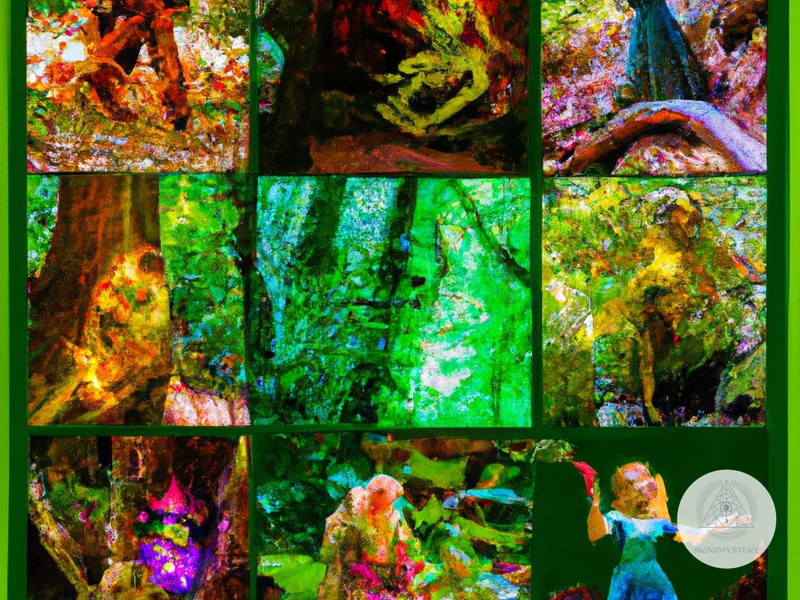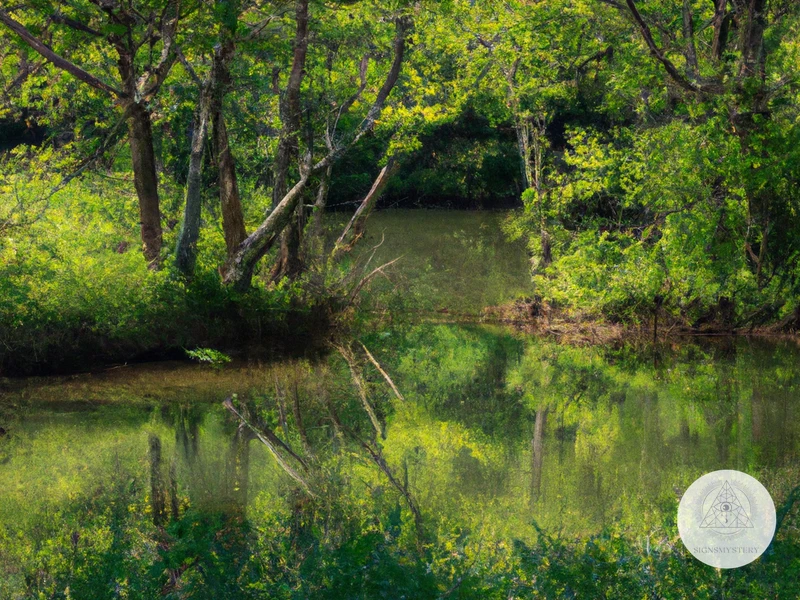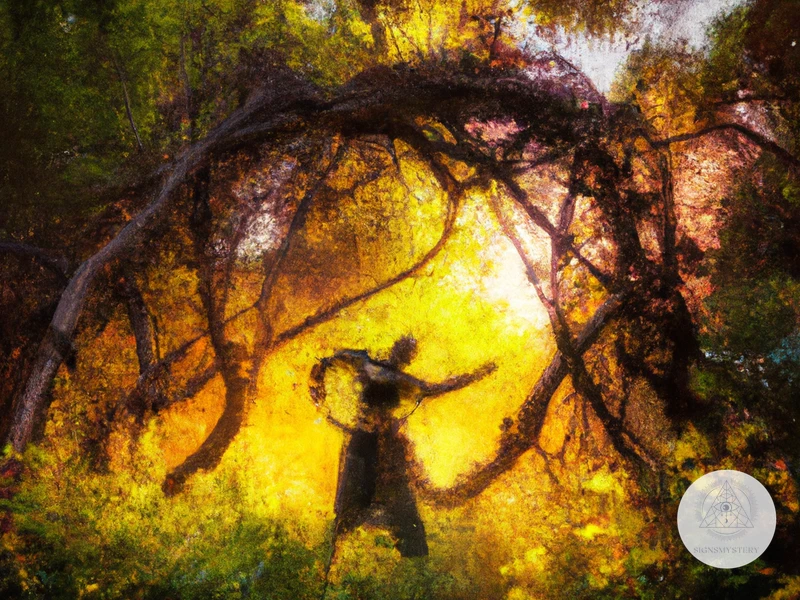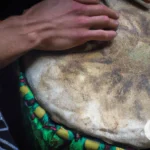Connecting with Nature Spirits through Shamanic Practices: A Journey into the Spirit World
Have you ever felt a deep connection to the natural world around you? Do you find solace in the whispering of the wind, the rustling of leaves, or the calming sound of running water? If so, you may be interested in exploring the ancient wisdom of shamanism and the practice of connecting with nature spirits. Shamanism is a spiritual practice that dates back thousands of years and is rooted in the belief that everything in the universe is interconnected. Through shamanic journeying, working with power animals, and engaging in rituals and ceremonies, individuals can tap into the energy and wisdom of nature spirits. In this article, we will delve into the world of shamans, explore different techniques for connecting with nature spirits, discuss the benefits of this practice, and provide steps for deepening your connection. So, grab your drum, open your mind, and let’s embark on a mystical journey into the spirit world.
What is Shamanism?

Shamanism is a spiritual practice that has been a part of indigenous cultures and traditions for centuries. At its core, shamanism is based on the belief that everything in the universe is interconnected and that there is a spiritual essence that resides in all things. Shamans are the intermediaries between the human world and the spirit world, using various techniques and practices to connect with spirits, including nature spirits. They harness the power of the elements, such as earth, air, fire, and water, and work with spirit guides and power animals to seek guidance, wisdom, and healing.
In shamanic cultures, shamans serve as healers, teachers, and spiritual leaders. They undergo rigorous training and often experience a calling or initiation to become shamans. One of the fundamental practices of shamanism is shamanic journeying, where the shaman enters an altered state of consciousness to travel to the spirit realms and communicate with spirits. This journeying can be done through drumming, rattling, chanting, or other rhythmic techniques.
Power animals also play a significant role in shamanic practices. These are animal spirits that act as guides and protectors for the shaman, offering their wisdom and assistance. Each power animal carries its own unique qualities and strengths that can be called upon by the shaman during their spiritual work. Power animals can be discovered through meditation, dreams, or deep connection with nature. They are seen as sources of power and companionship for the shaman on their spiritual journey.
Connecting with Nature Spirits
Connecting with Nature Spirits is the essence of shamanic practices. It involves establishing a deep and meaningful connection with the spirits of nature, including elementals, devas, ancestors, and spirit guides. By bridging the gap between the physical and spiritual realms, individuals can tap into the vast wisdom and healing energy that nature spirits offer. Shamanic journeying is a common technique used to connect with nature spirits. During a shamanic journey, one enters a trance-like state of consciousness and travels to the spirit realm, where they can encounter and communicate with these spirits. Another way to connect with nature spirits is through the guidance and support of power animals. These animal spirits serve as protectors and allies, offering their unique strengths and wisdom to aid in the spiritual journey. By engaging in rituals, ceremonies, and deepening the relationship with nature, individuals can foster a profound connection with nature spirits and experience the transformative power that they bring.
Shamanic Journeying
Shamanic Journeying is a core practice in shamanism that allows individuals to enter an altered state of consciousness and travel to the spirit realms to connect with nature spirits and spiritual guides. During a shamanic journey, the practitioner typically lies down, closes their eyes, and uses rhythmic drumming, rattling, or chanting to induce a trance-like state. This altered state of consciousness opens a doorway for the shaman to explore the realms beyond the physical world.
In the spirit realms, the shaman can encounter a variety of beings, including power animals, spirit guides, and nature spirits. These encounters can provide valuable insights, guidance, healing, and spiritual growth. The shamanic journey is an opportunity to seek answers to specific questions, receive direct teachings, or simply connect with the spiritual energies of the natural world.
It is common for shamans to have a designated “journey space” or sacred area where they perform their shamanic journeys. This space is intentionally created to be safe, protected, and conducive to connecting with the spirit realms. Tools such as feathers, crystals, or sacred objects may be used to enhance the journey experience and establish a connection with the unseen energies.
During the journey, it is important for the practitioner to maintain a relaxed and receptive state, allowing the senses and intuition to guide them. The shaman must remain open to whatever experiences unfold, as each journey is unique and can bring unexpected encounters and messages from the spirits.
After the journey, it is common practice for the shaman to journal or reflect on their experiences, as this can provide further understanding and integration of the messages received. By honing their journeying skills and developing a strong connection with the spirit realms, shamans can deepen their understanding of the interconnectedness of all things and their role as a bridge between the physical and spiritual realms.
Shamanic journeying is a powerful tool for connecting with nature spirits and gaining profound insights into the mysteries of the universe. Whether seeking guidance, healing, or spiritual growth, this practice allows individuals to tap into the wisdom and energies of the unseen realms, fostering a deeper connection with nature and the spiritual dimensions.
Working with Power Animals
Working with Power Animals
In shamanic practices, power animals are revered as spiritual guides and allies that offer their wisdom, strength, and protection. These animal spirits are seen as a source of power and connection to the natural world. Each power animal possesses unique qualities and characteristics that can be invoked by the shaman during their spiritual work. Here are some ways to work with power animals:
1. Discovering Your Power Animal: Power animals can reveal themselves to you through meditation, dreams, or deep connection with nature. They may come to you in the form of vivid dreams or recurring encounters with a particular animal in the physical world. Pay attention to any animals that catch your attention or appear with unusual frequency, as they may be trying to communicate with you. You can also seek guidance from a shamanic practitioner or use divination tools like oracle cards or animal totems to help you discover your power animal.
2. Building a Relationship: Once you have identified your power animal, it is important to establish a relationship with them. Take time to research the symbolism and characteristics associated with your power animal. Learn about their natural habitats, behaviors, and cultural significance. Spend time in nature, observing and connecting with the animal’s energy. Create a sacred space for yourself where you can honor and commune with your power animal. This can be an altar dedicated to them or a designated spot in nature where you feel a strong connection.
3. Invoking Their Energy: When working with your power animal, you can call upon their energy and seek their guidance during shamanic rituals, healing sessions, or daily spiritual practices. To connect with their energy, close your eyes, take deep breaths, and visualize your power animal in your mind’s eye. Imagine their presence surrounding you and feel their strength and wisdom permeating your being. You can also use physical representations of your power animal, such as statues, images, or symbols, to anchor their energy during your practice.
4. Honoring and Expressing Gratitude: It is essential to honor and show gratitude to your power animal for their presence and assistance. You can do this by leaving offerings for them, such as food, water, or symbolic items, on your altar or in nature. Express your thanks through prayers, songs, or words of appreciation. Regularly check in with your power animal, acknowledge their support, and ask for their guidance when needed.
Remember, each individual’s experience with power animals is unique. The symbolism and meaning associated with each animal can vary across cultures and personal interpretations. Pay attention to your own intuitive insights and feelings when working with your power animal, as they will guide you towards a deeper connection and understanding.
Rituals and Ceremonies
Rituals and ceremonies are integral to shamanic practices, serving as powerful tools for connecting with nature spirits. These sacred rituals create a space of reverence, intention, and energy alignment, allowing the shaman to open channels of communication with the spirit world. Shamanic rituals often take place in natural settings, such as forests, mountains, or bodies of water, as these environments are seen as bridges between the physical and spiritual realms.
One common shamanic ritual is the use of smudging, which involves the burning of herbs, such as sage or palo santo, to purify the energy and create a sacred space. The smoke is believed to carry prayers and intentions to the spirit world, while also clearing away any negative or stagnant energies that may hinder the connection with nature spirits.
Another essential aspect of shamanic rituals is the use of ceremony and symbolism. Ritual objects, such as feathers, crystals, or sacred symbols, are often incorporated to represent aspects of nature or specific spirit energies. These objects are charged with intention and serve as focal points for the shaman and participants, helping to anchor their focus and energy during the ritual.
Chanting, singing, or reciting mantras are also common practices in shamanic ceremonies. The vibrations and rhythms created through these vocal expressions can help shift consciousness, elevate spiritual energies, and facilitate a deeper connection with nature spirits. Drumming and rattling are additional forms of sonic invocation used by shamans to induce trance-like states and journey into the spirit realms.
Shamanic ceremonies may involve the use of sacred plants, such as ayahuasca or peyote, in cultures where their ceremonial use is traditional and respected. These plant medicines are believed to have the power to expand consciousness, enhance spiritual awareness, and provide profound insights into the interconnectedness of all things.
Ultimately, rituals and ceremonies within shamanic practices serve as bridges that enable shamans to enter altered states of consciousness, commune with nature spirits, and seek guidance, healing, and wisdom from the spiritual realms. They create a sacred container where the boundaries between the mundane and the divine blur, allowing for deeply transformative experiences and a profound connection to the natural world.
Benefits of Connecting with Nature Spirits

Connecting with nature spirits through shamanic practices offers a myriad of benefits that can deeply enrich our lives. By establishing a connection with these spiritual beings, we can tap into their wisdom and guidance, leading to personal growth and transformation. Here are some notable benefits of connecting with nature spirits:
1. **Heightened awareness:** Engaging with nature spirits allows us to develop a heightened sense of awareness and attunement to the natural world. We become more attuned to the subtle energies and messages that nature has to offer. This expanded awareness can bring a sense of peace, harmony, and interconnectedness.
2. **Wisdom and guidance:** Nature spirits hold vast wisdom and knowledge about the natural world and its cycles. By connecting with them, we can gain insights and guidance regarding various aspects of our lives. They can assist us in making decisions, provide clarity during challenging times, and offer guidance on our spiritual path.
3. **Healing and transformation:** Nature spirits have the power to facilitate healing on emotional, mental, and spiritual levels. Their energy can help us release stagnant emotions, negative patterns, and past traumas, leading to deep transformation and personal growth. They can also provide support in our healing journeys by offering comfort, nurturing, and energetic alignment.
4. **Connection to the Earth:** Nature spirits serve as a bridge between humans and the Earth. By connecting with them, we strengthen our bond with the natural world and develop a deeper appreciation for its beauty and importance. This connection fosters a sense of stewardship and encourages us to live in harmony with the Earth, promoting environmental consciousness and sustainability.
5. **Spiritual guidance and protection:** Nature spirits, such as power animals and spirit guides, act as guardians and allies on our spiritual journey. They offer protection, support, and guidance as we navigate our paths. Their presence can bring a sense of comfort, trust, and empowerment, helping us overcome challenges and obstacles along the way.
Connecting with nature spirits opens us up to a world of spiritual wisdom, healing, and connection. It deepens our relationship with the natural world and enhances our overall well-being. By embracing these practices, we can embark on a transformative journey of self-discovery and spiritual growth.
(More on the symbolism of spirit animals can be foundhere).
Tools for Shamanic Practices
Tools are essential for shamanic practices as they assist in creating a sacred space and enhancing the connection with nature spirits. Drumming and rattles are commonly used tools in shamanic rituals to induce trance-like states and shift consciousness. The rhythmic beats and vibrations help the practitioner enter altered states of awareness where they can journey to the spirit realms. Crystals and stones are also utilized for their energetic properties, with each crystal carrying unique vibrations that can enhance the connection to spiritual energies. They can be used for healing, protection, and guidance during shamanic practices. Another tool often employed is the use of herbs and incense. These aromatic elements help purify the environment and create a sacred atmosphere. They are believed to facilitate communication with nature spirits and invoke their presence. By incorporating these tools into shamanic practices, individuals can deepen their connection with the spiritual realm and explore the profound wisdom and guidance available to them.
Drumming and Rattles
Drumming and rattles are powerful tools used in shamanic practices to induce trance-like states and connect with the spirit world. These rhythmic instruments have been used for centuries by shamans across different cultures and traditions.
Drumming: The beating of a drum creates a steady and repetitive rhythm that helps to shift the consciousness of the practitioner. As the drumming continues, the mind begins to enter a state of relaxation and the body becomes more receptive to spiritual energies. The drumming acts as a bridge between the physical and spiritual realms, allowing the shaman to journey into the depths of the spirit world. The steady beat of the drum also helps to synchronize brainwaves, leading to altered states of consciousness and heightened spiritual awareness.
Rattles: Rattles, on the other hand, produce a different sound and vibration. The shaking of a rattle creates a subtle and rhythmic noise that can help to clear stagnant energy and create a sacred space. Rattles are often used to call in and awaken the spirits, inviting them to join the shaman in their journey or ceremony. The sound of the rattle is believed to dispel negative energies and create a protective barrier around the practitioner. As the shaman shakes the rattle, they become more attuned to the subtle energies of the spirit world, allowing for a deeper connection and communication with nature spirits.
Both drumming and rattles can be used in a variety of shamanic practices, such as journeying, healing ceremonies, and rituals. The steady rhythm of drums and the gentle sound of rattles help to create a sacred and harmonious atmosphere, facilitating the connection with nature spirits. By using these tools, the shaman is able to enter a trance-like state, open themselves up to spiritual guidance, and tap into the ancient wisdom of the natural world.
To learn more about the use of sacred tools in shamanic practices, you can read the article on the symbolism of the leopard spirit guide in African traditions.
Crystals and Stones
Crystals and stones are powerful tools that are often used in shamanic practices to enhance connection with nature spirits. Each crystal and stone carries its own unique energy and properties, making them valuable allies in spiritual work. They can be used in a variety of ways, depending on the intention and purpose of the shaman.
– Clear Quartz: Known as the “Master Healer,” clear quartz is a versatile crystal that amplifies energy and can be used for healing, protection, and enhancing spiritual connection. It helps to cleanse and purify the energy field, making it a useful tool for clearing any energetic blockages that may hinder communication with nature spirits.
– Amethyst: With its gentle yet powerful energy, amethyst is often used for spiritual growth, intuition, and connecting with higher realms. It can assist in opening the third eye and crown chakras, facilitating a deeper connection to spiritual guides and nature spirits. When working with amethyst, shamans may experience enhanced psychic abilities and a greater sense of spiritual awareness.
– Rose Quartz: As a stone of love and compassion, rose quartz can bring a heart-centered approach to shamanic practices. It fosters a sense of nurturing and connection, allowing shamans to connect with nature spirits on an emotional level. Rose quartz can help to open and heal the heart chakra, enhancing the ability to receive and give love to the spirits of nature.
– Black Tourmaline: Known for its protective properties, black tourmaline can shield the shaman from negative energies and entities during spiritual work. It acts as a grounding stone, keeping the shaman connected to the earth while exploring the realms of spirit. With black tourmaline, shamans can feel safe and protected as they engage with the energies of nature spirits.
– Citrine: A stone of abundance and manifestation, citrine can support shamans in manifesting their intentions and desires in their spiritual work. It carries a vibrant energy that can uplift the spirit and bring joy and positivity to the shaman’s connection with nature spirits. Citrine can also help to activate the solar plexus chakra, enhancing personal power and confidence during shamanic practices.
By incorporating crystals and stones into their rituals and ceremonies, shamans can create a sacred and energetically charged space for connecting with nature spirits. These tools can be placed on altars, held during meditation, or used in crystal grids to amplify the shaman’s energy and intention. It’s important for shamans to intuitively select the crystals and stones that resonate with them and their specific intentions for connecting with nature spirits.
Herbs and Incense
In shamanic practices, the use of herbs and incense plays a vital role in creating sacred space, purifying energies, and enhancing spiritual connection. Herbs have been used for their medicinal and spiritual properties for centuries, and they are believed to have the ability to clear stagnant energy, open the mind, and facilitate communication with nature spirits. Different herbs carry different energies and purposes. For example, sage is often used for purification and cleansing, while lavender is revered for its calming and soothing effects. Incense, on the other hand, is used to purify the air and create a sacred atmosphere during ceremonies and rituals. The aromatic smoke produced by burning incense is believed to carry prayers and intentions to the spirit realm. The choice of incense can vary depending on the desired outcome or the spirit being invoked. Sandalwood is commonly used for its grounding and protective properties, while frankincense is associated with spiritual elevation and connection. By incorporating herbs and incense into shamanic practices, practitioners are able to create a sacred and energetically charged environment that supports their connection with nature spirits and enhances their spiritual experiences. So, gather your favorite herbs and choose the incense that resonates with your intention, and let their aromatic presence guide you on your shamanic journey.
Preparing for a Shamanic Journey

Preparing for a Shamanic Journey involves creating the right mindset and environment for a deep and meaningful connection with nature spirits. Setting intentions is an important first step, as it helps to focus the mind and clarify the purpose of the journey. This can include seeking guidance, healing, or simply gaining insights and wisdom. Cleansing and grounding practices are also essential to clear any negative or stagnant energy from the body and establish a strong foundation. This can be done through meditation, smudging with herbs like sage or palo santo, or immersing in nature. Creating a sacred space further enhances the journey by providing a safe and sacred container for the experience. This can be done by arranging sacred objects, lighting candles, and using crystals to amplify the energy. By taking these preparatory steps, individuals can enter the shamanic state of consciousness with clarity, openness, and receptivity, allowing for a profound connection with nature spirits and the wisdom they impart.
Setting Intentions
Setting Intentions:
Setting intentions is a crucial step in preparing for a shamanic journey or any spiritual practice. It involves consciously directing your focus and energy towards a specific purpose or goal. By doing so, you align your mindset and create a clear intention for your journey, which can enhance the depth and effectiveness of your experience.
To set intentions before a shamanic journey, start by finding a quiet and sacred space where you can be free from distractions. Take a few moments to ground yourself by taking deep breaths and connecting with the present moment. Then, consider what you wish to explore, learn, or heal during your journey.
It is essential to frame your intentions in a positive and empowering way. Instead of focusing on what you want to release or let go of, focus on what you want to invite or embrace into your life. For example, rather than intending to “let go of fear,” you can set an intention to “cultivate courage and inner strength.”
Writing down your intentions can be a helpful practice as well. Put pen to paper and express your intentions with clarity and conviction. This act of writing solidifies your commitment to the intentions and serves as a reminder during your journey.
During the journey, keep your intentions in mind and use them as a guiding compass. Allow the spirits and nature beings you encounter to provide insights and wisdom that align with your intentions. Remember, the intentions you set are like the threads that weave your experience together, guiding you towards transformation and growth.
If you want to understand more about the importance of setting intentions, you can explore the spiritual meaning of hawks and their vision awareness. Hawks are often associated with clear sight and intuition, making them powerful symbols for setting intentions and gaining clarity in your spiritual practices.
Cleansing and Grounding
Cleansing and grounding are essential practices in shamanic journeys and connecting with nature spirits. They help clear any stagnant or negative energy and create a solid foundation for spiritual work. Cleansing involves purifying the body, mind, and spirit, while grounding focuses on establishing a strong connection with the Earth.
To cleanse, one can use various techniques such as smudging with sacred herbs like sage or palo santo, taking a ritual bath with sea salt or herbs, or simply visualizing a stream of pure, cleansing light washing over them. This process removes any energetic blockages or attachments that may hinder the connection with nature spirits. Cleansing can also involve reciting affirmations or prayers to release any negativity and invite positive energy.
Grounding, on the other hand, is about aligning with the Earth’s energy and establishing a firm anchor in the physical realm. This can be done by standing barefoot on the ground, feeling the earth beneath your feet, and visualizing roots extending from your body into the ground. Deep breathing exercises and conscious awareness of the body’s connection to the earth’s energy also aid in grounding.
By combining cleansing and grounding practices, individuals create a harmonious and receptive state for connecting with nature spirits. This state allows for a clearer channel of communication and a deeper connection with the spiritual realms. Cleansing and grounding are foundational steps on the spiritual path, helping to purify and strengthen the practitioner’s energy, opening the way for transformative experiences and insights. So, before embarking on a shamanic journey or connecting with nature spirits, always remember to cleanse and ground yourself to create the optimal conditions for spiritual exploration and growth.
For more information on spiritual practices and the power of vision, you can refer to our article on the spiritual meaning of hawk’s vision and awareness.
Creating Sacred Space
Creating Sacred Space
Creating a sacred space is an essential step in preparing for any shamanic journey or spiritual practice. The purpose of a sacred space is to establish a container of energy that is safe, protected, and conducive to connecting with nature spirits. Here are some steps to follow when creating a sacred space:
1. Clearing the space: Begin by clearing the physical space of any clutter or distractions. You can also energetically clear the space by smudging with herbs, such as sage or palo santo, or using sound tools like bells or singing bowls. This helps to remove any stagnant or negative energy and creates a clean slate for your practice.
2. Setting intentions: Set clear intentions for your sacred space. What do you hope to achieve through your connection with nature spirits? What guidance or insights are you seeking? By clearly stating your intentions, you align your energy and focus.
3. Creating an altar: An altar serves as a focal point for your sacred space. It can be a small table or surface where you arrange objects that hold personal meaning or symbolism. Items such as crystals, feathers, seashells, and images of nature spirits can be placed on the altar. This sacred space acts as a visual representation of your intention and helps to anchor the energy.
4. Lighting candles: The soft glow of candles can create a serene and reverent atmosphere. Choose candles that resonate with you, whether they are scented or unscented. Lighting candles symbolizes the presence of divine energy and invites the spirits to join you in your practice.
5. Sacred objects and symbols: Incorporate sacred objects and symbols that hold meaning for you. This could be a cherished artifact, a symbol of a nature spirit, or a special piece of jewelry. These objects serve as reminders of the sacredness of the space and can help to deepen your connection.
Remember, creating a sacred space is a personal and individual process. Trust your intuition and choose elements that resonate with you. This space is where you will commune with nature spirits, receive guidance, and embark on transformative journeys. Treat it with reverence and respect, and it will become a portal for sacred experiences.
Steps for Connecting with Nature Spirits
When it comes to connecting with nature spirits, there are specific steps that can be followed to facilitate a deeper connection and communication. The first step is to enter the shamanic state of consciousness through various techniques such as breathwork, meditation, or rhythmic drumming. This altered state allows one to access the spirit realms and connect with nature spirits. Once in this state, the individual can then focus on meeting a nature spirit guide. This can be done by setting intentions and visualizing a meeting with a guide who resonates with their energy. Building a relationship with the guide is the next step, which involves regular communication and collaboration. This can be accomplished through offerings, rituals, and spending time in nature. By nurturing this connection and showing respect, the bond between the individual and the nature spirit guide can deepen. Through these steps, individuals can establish a profound and meaningful relationship with nature spirits, gaining wisdom, guidance, and a greater understanding of the natural world.
Entering the Shamanic State of Consciousness
Entering the Shamanic State of Consciousness
To connect with nature spirits in shamanic practices, it is essential to enter a shamanic state of consciousness. This altered state allows you to access the subtle realms and communicate with the spirits. Here are some techniques for entering the shamanic state of consciousness:
1. Meditation: Start by finding a quiet and comfortable space where you can relax. Close your eyes and focus on your breath, allowing your mind to become calm and centered. Visualize yourself in a natural setting, such as a forest or meadow, to create a sense of connection with the spiritual realm.
2. Drumming and Rattling: Drumming and rattling are powerful tools for shifting consciousness. The rhythmic beats and vibrations can induce a trance-like state. Use a drum or a rattle and begin to play with a steady beat. Let the sound and rhythm guide you into a meditative state.
3. Chanting and Mantras: Chanting and repetitive vocal sounds can help induce an altered state of consciousness. Find a chant or mantra that resonates with you and repeat it soothingly. Focus on the vibrations and the energy it creates within you.
4. Dancing and Movement: Movement can be another way to shift consciousness. Allow your body to move freely, expressing yourself through dance. Feel the connection between your physical body and the spiritual realm.
5. Sacred Herbs and Plants: Some practitioners use sacred herbs and plants, such as sage, palo santo, or mugwort, to help alter their consciousness. These plants have been used for centuries in shamanic rituals to induce a deeper connection with nature and the spirit world.
Remember, everyone’s journey into the shamanic state of consciousness may vary. What is important is finding the technique that resonates with you and allows you to enter the altered state necessary for connecting with nature spirits. Experiment with different methods and trust your intuition to find the one that works best for you.
Meeting a Nature Spirit Guide
Meeting a Nature Spirit Guide
Meeting a nature spirit guide is a profound and transformative experience within shamanic practices. These guides are spiritual beings that exist within the natural world and can offer guidance, wisdom, and support to those who seek their assistance. To meet a nature spirit guide, one must first enter the shamanic state of consciousness through techniques such as drumming, chanting, or meditation. Then, with intention and an open heart, the shaman invites the spirit guide to make its presence known.
During this process, it is important to be receptive to the subtle signs and messages that the guide may communicate. This can come in the form of visions, sensations, or even auditory impressions. Each guide has its own unique energy and appearance, which may manifest as an animal, plant, elemental being, or ancestral spirit.
When meeting a nature spirit guide, it is crucial to approach with respect and humility. Express gratitude for their presence and willingness to connect. The shaman may ask for the guide’s name and seek guidance or clarity on specific aspects of their spiritual journey or current challenges they may be facing.
Developing a relationship with a nature spirit guide requires trust, consistency, and open communication. Regularly honor and acknowledge the presence of the guide through offerings, prayer, or rituals. This strengthens the connection and deepens the bond between the shaman and the spirit guide.
It is important to remember that the relationship with a nature spirit guide is symbiotic – they offer guidance and support, and the shaman reciprocates with respect, gratitude, and willingness to learn. With time and practice, the shaman can co-create a profound and lasting relationship with their nature spirit guide, enriching their spiritual journey and expanding their understanding of the natural world and its wisdom.
Building a Relationship
Building a Relationship with Nature Spirits
Once you have made initial contact with a nature spirit guide during your shamanic journey, the next step is to build a relationship with them. Just like any relationship, this requires time, patience, and respect. Here are some steps to help you foster a strong connection with your nature spirit guide:
1. Express Gratitude: Begin by expressing gratitude for the guidance and presence of the nature spirit. Offer your thanks for their willingness to communicate with you and be a guiding force in your spiritual journey.
2. Regular Communication: Keep the lines of communication open by regularly connecting with your nature spirit guide. You can do this through meditation, journeying, or simply spending time in nature with the intention of connecting with them. Open your heart and mind to receive any messages or insights they may have for you.
3. Offerings and Gifts: Consider making offerings or giving gifts to your nature spirit guide as a gesture of appreciation. This can be done with items found in nature, such as flowers, herbs, or stones.
Subscribe to Our Newsletter
Sign up to receive the latest news and updates.
4. Active Listening: Practice active listening when communicating with your nature spirit guide. Pay attention to any signs, symbols, or synchronicities that may appear in your everyday life. These can be messages from the spirit guide, offering guidance or confirmation.
5. Trust and Intuition: Trust in the guidance and messages you receive from your nature spirit guide. Follow your intuition and allow the wisdom of the spirit to guide your decisions and actions. Trust that the spirit has your best interests at heart and is there to support you on your spiritual path.
Remember, building a relationship with nature spirits takes time and dedication. Stay committed to the process, remain open-minded, and nurture the connection with love and respect. As you deepen your relationship, you will continue to receive valuable insights, guidance, and transformative experiences from these powerful beings.
Common Nature Spirits

Common Nature Spirits
Nature spirits are mystical beings that are deeply connected to the natural world. They are the guardians and caretakers of different elements of nature, embodying the energy and essence of their specific realm. There are various types of nature spirits that can be encountered in shamanic practices. Elementals are nature spirits associated with the elements of earth, air, fire, and water. These spirits can be found in forests, mountains, bodies of water, and other natural landscapes. Devas are higher-level nature spirits that oversee and protect entire ecosystems, such as forests or meadows. They work in harmony with the Earth’s energy and guide the growth and balance of these environments. Additionally, shamanic practices often involve connecting with one’s ancestors and spirit guides, who are considered nature spirits due to their connection to the spiritual realm and ability to provide guidance and support. Each of these nature spirits offers a unique perspective and energy, allowing individuals to deepen their connection to the natural world and gain insights into their own lives.
Elementals
Elementals are a fascinating aspect of nature spirits within shamanic practices. They are believed to be the essence and embodiment of the four elements – earth, air, fire, and water. Each elemental carries its own unique energy and characteristics. Here are the different types of elementals:
1. Earth Elementals: Also known as gnomes or earth spirits, these beings are connected to the earth element. They are associated with the physical realm and the natural world. Earth elementals are often depicted as small, dwarf-like creatures who reside in forests, caves, or underground. They are guardians of the land and possess great wisdom in plant medicine and earth healing.
2. Air Elementals: Sylphs or air sprites represent the air element. They are airy and ethereal beings, often depicted as graceful, winged creatures. Air elementals are associated with the realm of the mind, communication, and inspiration. They can bring insights, creativity, and clarity to those who connect with them. Sylphs are said to reside in higher altitudes, such as mountaintops or clouds.
3. Fire Elementals: Known as salamanders or fire spirits, these entities embody the fire element. They are associated with passion, transformation, and the catalytic energy of fire. Fire elementals are often described as flickering flames or fiery beings. They hold the power of purification and can assist in burning away obstacles or old patterns. Salamanders are said to reside in areas of intense heat or fire, such as volcanoes or wildfires.
4. Water Elementals: Nymphs or undines represent the water element. They embody the fluidity, emotions, and intuition of water. Water elementals are often portrayed as graceful, mermaid-like beings or as gentle spirits found near bodies of water. They hold the healing power of water and can assist in emotional healing and cleansing. Nymphs are said to reside in lakes, rivers, or oceans.
To connect with elementals, it’s important to approach them with respect and reverence. They can be reached through meditation, visualization, or during shamanic journeys. By cultivating a deep connection with these elemental spirits, one can tap into their wisdom, receive guidance, and work in harmony with the natural world.
Devas
Devas are spiritual beings or nature spirits that are often associated with the plant kingdom. In various shamanic traditions and belief systems, devas are seen as guardians and caretakers of the natural world. They are believed to embody the essence and energy of plants, flowers, trees, and other forms of plant life. Deva is a Sanskrit word meaning “shining one” or “radiant being,” and they are often considered intermediaries between humans and the natural world.
According to shamanic practices, devas can be communicated with and worked with to deepen our connection to nature and gain insight and wisdom from the plant realm. Shamanic practitioners believe that devas can share their knowledge and healing properties, allowing us to tap into the innate wisdom of plants for physical, emotional, and spiritual healing. By connecting with devas, individuals can develop a deeper understanding of the holistic interconnectedness of all living things.
To connect with devas during shamanic practices, it is important to approach them with respect and gratitude. This can be done through rituals, ceremonies, or simply by spending time in nature, observing and appreciating the beauty and presence of plants. Communication with devas can be intuitive, through meditation, or by attuning oneself to the subtle energies present in the plant kingdom.
Working with devas can bring about a sense of harmony, balance, and alignment with the natural world. By honoring and acknowledging the devas, we can cultivate a deeper reverence for nature and develop a greater sense of interconnectedness with the living beings that surround us. Through this connection with devas, shamanic practitioners can gain profound insights, spiritual growth, and enhanced healing abilities in their practice.
Ancestors and Spirit Guides
Ancestors and Spirit Guides are revered and honored beings in shamanic practices. Ancestors are the spirits of our lineage, the ones who came before us, and hold a wealth of wisdom and knowledge. They offer guidance, protection, and support to those who seek their connection. Shamanic practitioners often create ancestral altars or sacred spaces where they can honor and communicate with their ancestors. This can involve placing photographs, heirlooms, or personal items on the altar as a way of invoking their presence.
Spirit Guides, on the other hand, are non-physical beings who serve as teachers, guardians, and allies on the spiritual path. They can take the form of animals, ancestors, ascended masters, angels, or other ethereal entities. Spirit guides offer insights, assistance, and spiritual protection to the shaman or individual seeking their guidance. Developing a relationship with spirit guides often involves meditation, journeying, and consistent communication. These guides can be called upon during ceremonies, rituals, or when seeking specific guidance or answers from the spirit realms.
Shamanic practitioners understand that connecting with ancestors and spirit guides is not limited to blood lineage or familial ties. One can establish strong connections with ancestral and spirit guides from different cultures and lineages. The focus is on building a respectful and reciprocal relationship with these spiritual beings, acknowledging their presence, and honoring their wisdom. The guidance and support from ancestors and spirit guides can greatly enhance one’s shamanic journey, providing insight, protection, and a sense of belonging within the spiritual realm.
Deepening Your Connection
Deepening Your Connection
Once you have established a connection with nature spirits through shamanic practices, it is important to nurture and deepen that bond. One way to do this is through offerings and honoring. By giving thanks to the nature spirits for their guidance and support, you show your respect and gratitude. Offerings can include items like flowers, food, or sacred herbs, which can be left in an outdoor space as a token of appreciation. Additionally, working with the elements can enhance your connection. Each element – earth, air, fire, and water – holds its own energy, and by consciously engaging with them, you can tap into their power and wisdom. For example, spending time near a body of water, like a river or ocean, can help you connect with the element of water and its nurturing qualities. Another way to deepen your connection is through nature rituals and celebrations. By participating in rituals that honor nature and its cycles, such as solstice celebrations or full moon ceremonies, you align yourself with the natural rhythms of the Earth and forge a deeper spiritual connection. Remember, deepening your connection with nature spirits is an ongoing journey that requires dedication, respect, and an open heart.
Offerings and Honoring
In shamanic practices, offerings and honoring play a vital role in deepening the connection with nature spirits. Offerings are gestures of appreciation, gratitude, and respect towards the spirits, recognizing their wisdom and guidance. These offerings can be physical or energetic, representing the intention and sincerity of the practitioner. The act of making offerings is a way to establish a reciprocal relationship with the spirits, showing that you value their presence and are willing to give in return.
Offerings can take various forms, depending on the tradition and personal preference. They may include fresh flowers, herbs, fruits, grains, or even sacred objects. The choice of offering can be guided by intuition or based on the symbolism associated with certain natural elements. For example, offering a feather may symbolize connection with the realm of birds and the spirit of air, while placing a crystal could represent a gift of the Earth’s energy.
When making an offering, it is important to approach the act with reverence and sincerity. Take a moment to center yourself, connect with your heart, and offer your intentions and gratitude. You can speak words of appreciation or silently express your thoughts and feelings. The key is to channel your genuine appreciation and energy into the offering, creating a sacred exchange between you and the spirits.
Honoring the nature spirits goes beyond the act of offering physical items. It involves recognizing the spiritual presence in all living beings and showing respect for the natural world. This can be done through simple acts of mindfulness, such as taking time to observe and appreciate the beauty of nature, engaging in eco-friendly practices, and participating in conservation efforts. By honoring the spirits of nature, we acknowledge our interconnectedness and the importance of preserving and nurturing the environment.
Remember, offerings and honoring are not transactions for personal gain, but rather gestures of respect and gratitude. They help foster a deeper connection with the nature spirits, allowing us to tap into their wisdom and guidance for our spiritual journey.
Working with the Elements
Working with the Elements is an integral part of shamanic practices when connecting with nature spirits. The elements – Earth, Air, Fire, and Water – are seen as powerful forces that exist both within and outside of us. Each element holds specific qualities and energies that can be invoked and harnessed for spiritual work.
Earth represents stability, grounding, and physical abundance. Shamanic practitioners connect with the Earth element by spending time in nature, meditating on the grounding energy of the earth, and working with crystals and stones to bring about balance and harmony.
Air symbolizes communication, intellect, and the power of the mind. When working with the Air element, shamans focus on breathwork, using the breath to calm the mind, gain clarity, and communicate with the spirit world. Smudging with herbs and incense can also be used to purify the air and create a sacred space for spiritual practices.
Fire embodies transformation, passion, and vitality. It is the element of energy and action. Shamanic practitioners connect with Fire through rituals involving candles, bonfires, or through working with the energy of the sun. Fire is seen as a potent tool for transformation and purification.
Water represents emotions, intuition, and healing. Shamans work with the energy of Water by engaging in rituals near bodies of water, using water as a means of cleansing and purifying, and connecting with the flow of emotions and intuition. Water is seen as a conduit for emotional healing and connecting with the subconscious.
By working consciously with the elements, shamans tap into the natural forces of the universe and align themselves with the energies that permeate all of creation. This deep connection with the elements allows for a more profound and harmonious relationship with nature spirits and enhances the shaman’s ability to receive guidance and insight from the spirit world.
Nature Rituals and Celebrations
Nature rituals and celebrations are powerful ways to deepen our connection with nature spirits and honor the natural world. These rituals and celebrations tap into the rhythms and cycles of nature, allowing us to align ourselves with the energy and wisdom of the earth. One example of a nature ritual is the practice of creating an outdoor altar. This can be done by carefully selecting natural objects such as stones, flowers, feathers, or shells, and arranging them in a sacred pattern or design. Placing offerings such as herbs, fruits, or sacred water on the altar can be a way of expressing gratitude and respect to the nature spirits. Another delightful ritual is the act of performing ceremonies during the changing seasons, such as solstices, equinoxes, or full moons. These rituals often involve dance, song, and prayer, creating a sacred space to connect with the elements and the spirit world. By participating in these rituals, we not only honor the spirits but also deepen our relationship with the natural world around us.
Integration and Reflection

Integration and Reflection: Nurturing the Shamanic Connection in Daily Life
Once you have embarked on your shamanic journey and forged a connection with nature spirits, it is essential to integrate and reflect upon your experiences to deepen your spiritual connection and allow the wisdom gained to permeate your daily life. Journaling and self-reflection are powerful tools for this purpose. Take time to write down your experiences, insights, and messages received from nature spirits during your shamanic practices. This process helps to solidify your understanding and allows you to revisit and learn from your past experiences. Additionally, applying shamanic insights to your daily life can bring about profound transformation. As you go about your daily routines, take the time to notice the subtle energies around you, listen to the whispers of nature, and align your actions with the guidance received from nature spirits. Integrating these practices into your life allows for a harmonious and balanced existence, deeply rooted in the wisdom of the spirit world.
Journaling and Self-Reflection
Journaling and Self-Reflection
Journaling and self-reflection are valuable tools for deepening your connection with nature spirits and integrating your shamanic experiences into daily life. Through the practice of journaling, you can record your thoughts, emotions, and insights gathered during shamanic journeys or rituals. This process allows you to gain a deeper understanding of your experiences and helps to capture any messages or guidance received from nature spirits.
When journaling, it is essential to create a safe and sacred space where you can freely express your thoughts and feelings. This can be done by finding a quiet and peaceful environment, lighting candles, and surrounding yourself with items that bring you comfort and inspiration, such as crystals or sacred symbols. By setting this sacred space, you create an atmosphere that supports your connection with nature spirits and encourages deep introspection.
Begin your journaling session by reflecting on your experiences. Start by asking yourself questions such as: What did I learn from my journey? How did I feel during the encounter with the nature spirit? Did any specific messages or symbols stand out to me? Writing down your answers and observations allows you to explore your experiences in depth and gain clarity on their significance.
In addition to recording your experiences, consider using your journal to explore your personal growth and transformation. Reflect on how your connection with nature spirits has influenced your thoughts, beliefs, and actions in your daily life. Are there any patterns or themes that emerge from your experiences? Take note of any synchronicities or signs that you encounter in your day-to-day interactions, as they may hold deeper meaning and can provide further insight into your connection with nature spirits.
Remember, journaling and self-reflection are ongoing practices. Set aside regular time to write in your journal and reflect on your shamanic experiences. As you continue to deepen your connection with nature spirits through shamanic practices, your journal becomes a powerful tool for self-discovery, growth, and integration of the wisdom gained from the spiritual realm into your everyday existence.
Applying Shamanic Insights to Daily Life
Applying Shamanic Insights to Daily Life
Once you have established a strong connection with nature spirits through your shamanic practices, you can begin to integrate their wisdom and guidance into your everyday life. Here are some ways you can apply shamanic insights to enrich your daily experiences:
1. Mindful Nature Connection: Take moments throughout your day to connect with the natural world around you. Whether it’s spending time in a nearby park, tending to a garden, or simply observing the movements of a bird outside your window, pay attention to the messages and symbolism nature brings forth. This practice helps to cultivate a deeper sense of awareness and gratitude for the interconnectedness of all life.
2. Living in Harmony: Embrace the principles of balance and harmony that are foundational in shamanism. This involves finding equilibrium within yourself and in your relationships with others and the world around you. Seek to align your actions with respect for nature, practicing sustainability, and making choices that honor and support the well-being of all beings.
3. Honoring Rituals: Incorporate rituals into your daily routine to create a sacred space for connection and healing. This can be as simple as lighting a candle, offering gratitude before meals, or setting intentions for the day ahead. By infusing your actions with intention and reverence, you deepen your connection to the spiritual energies within and around you.
4. Meditation and Reflection: Set aside time each day for quiet reflection and meditation. This allows you to delve deeper into your own inner wisdom and connect with the higher realms of consciousness. You can use this time to seek guidance, clarity, and inspiration from nature spirits and your spirit guides.
5. Embracing Synchronicities: Pay attention to synchronicities and meaningful coincidences that occur in your life. These are often signs and messages from the spirit world, guiding you along your path. By remaining open and aware, you can recognize and interpret these signs, applying their insights to your daily experiences.
By incorporating these shamanic insights into your daily life, you embark on a transformative journey of self-discovery, connection, and spiritual growth. Remember to approach this practice with an open heart, a curious mind, and a willingness to embrace the profound teachings that nature spirits have to offer.
Conclusion
In conclusion, connecting with nature spirits through shamanic practices can be a transformative and enriching experience. By delving into the spiritual realm and establishing a relationship with nature spirits, individuals can gain insight, guidance, and healing. Through shamanic journeying, working with power animals, and engaging in rituals and ceremonies, we can tap into the ancient wisdom of the natural world and deepen our connection to the interconnectedness of all things.
The benefits of connecting with nature spirits are multifold. It allows us to develop a deeper appreciation and respect for the natural world, fostering a sense of harmony and balance within ourselves and the environment. The wisdom and guidance offered by nature spirits can help us navigate life’s challenges, gain clarity and perspective, and find inner peace. Additionally, connecting with nature spirits can bring a sense of empowerment and connectedness to something greater than ourselves.
As we embark on our shamanic journey, it is important to utilize tools such as drumming and rattles, crystals and stones, and herbs and incense to enhance our spiritual connection. Preparing for a shamanic journey involves setting intentions, cleansing and grounding ourselves, and creating a sacred space where we can enter the shamanic state of consciousness.
By entering the shamanic state of consciousness, we open ourselves to the possibility of meeting nature spirit guides, who can offer profound insights and companionship on our spiritual journey. Building a relationship with these guides involves mutual respect, reciprocity, offerings, and honoring of their wisdom and presence.
Common nature spirits, such as elementals, devas, and ancestors, each bring their unique energy and teachings. By deepening our connection with them, we can gain a deeper understanding of the elements, the natural world, and our own spiritual path. This can be done through offerings, working with the elements, and participating in nature rituals and celebrations.
Integration and reflection are crucial aspects of the shamanic journey. Journaling and self-reflection allow us to process our experiences, insights, and messages from nature spirits. Applying these shamanic insights to our daily lives can lead to personal growth, healing, and a greater sense of purpose.
In conclusion, connecting with nature spirits through shamanic practices is a sacred and profound journey that can bring us closer to the beauty, wisdom, and interconnectedness of the natural world. By embracing these practices with respect, intention, and an open heart, we can cultivate a deeper connection with nature spirits and experience the transformative power they offer.
Frequently Asked Questions

What are nature spirits?
Nature spirits are considered to be the essence or energy present in natural elements, such as trees, plants, animals, rocks, and bodies of water. They are believed to have their own consciousness and can be perceived as guardian spirits or beings that embody the spirit of a particular element or aspect of nature.
How can shamanic journeying help in connecting with nature spirits?
Shamanic journeying involves entering an altered state of consciousness to communicate with spirits and explore the spirit world. During these journeys, shamans can connect with nature spirits, receive guidance, and build relationships with them. It provides a direct pathway for establishing a deep connection and understanding of the natural world.
What is the role of power animals in shamanic practices?
Power animals are spiritual guides that serve as sources of strength, protection, and wisdom in shamanic practices. They can offer guidance, reveal hidden knowledge, and assist with healing. Power animals are seen as trusted companions and allies on the shaman’s spiritual journey.
Can anyone connect with nature spirits through shamanic practices?
Yes, anyone with an open mind and a willingness to explore the spiritual realm can connect with nature spirits through shamanic practices. It does not require any particular belief system or cultural background.
Are there different types of nature spirits?
Yes, there are various types of nature spirits, each with its own unique qualities and characteristics. Some examples include elementals, devas, and spirit guides. These spirits may have different roles, energies, and areas of influence in the natural world.
How can rituals and ceremonies enhance the connection with nature spirits?
Rituals and ceremonies provide a focused and intentional space for connecting with nature spirits. They create a sacred atmosphere, invoke the presence of spirits, and allow for deeper engagement and communion. Rituals and ceremonies can include offerings, prayers, chants, and specific actions to honor and connect with the spirits.
What are some tools used in shamanic practices?
Shamans use various tools to aid in their practices, such as drums, rattles, crystals, stones, herbs, and incense. These tools can help shift consciousness, create sacred space, and amplify energy during rituals and ceremonies.
Why is setting intentions important in preparing for a shamanic journey?
Setting intentions before a shamanic journey helps to focus the mind and energy on a specific purpose or goal. It clarifies what you seek to gain from the journey and establishes a clear intention for connecting with nature spirits.
What does it mean to enter the shamanic state of consciousness?
Entering the shamanic state of consciousness refers to shifting into an altered state of awareness where the veils between the physical and spirit worlds are thin. This state allows the shaman to perceive and interact with the spirit realm, including nature spirits.
How can journaling and self-reflection deepen the connection with nature spirits?
Journaling and self-reflection serve as tools for integrating and processing the experiences and insights gained from connecting with nature spirits. It allows for a deeper understanding of the messages received, personal growth, and ongoing connection to the spiritual realm.
References
Frequently Asked Questions

What are nature spirits?
Nature spirits are believed to be the spiritual essence or consciousness that inhabits various elements of the natural world, such as plants, animals, and natural landscapes.
How can shamanic practices help connect with nature spirits?
Shamanic practices provide tools and techniques to enter altered states of consciousness, allowing individuals to connect with nature spirits on a deeper level and establish a meaningful relationship with them.
What is shamanic journeying?
Shamanic journeying is a practice where individuals enter a trance-like state using rhythmic drumming or other techniques. This allows them to travel to non-ordinary reality, the realm where nature spirits reside, and communicate with them.
How can power animals assist in connecting with nature spirits?
Power animals are spiritual beings that take the form of animals. They act as guides and allies in shamanic practices, helping individuals navigate the spirit realm and establish connections with nature spirits.
What role do rituals and ceremonies play in connecting with nature spirits?
Rituals and ceremonies provide a structured framework for individuals to connect with nature spirits. These practices create a sacred space and set intentions, allowing for a deeper and more meaningful connection with the spiritual realm.
What are the benefits of connecting with nature spirits?
Connecting with nature spirits can bring a sense of harmony, healing, and balance to one’s life. It can also deepen one’s understanding of the interconnectedness of all living beings and foster a sense of reverence for the natural world.
How do drumming and rattles enhance shamanic practices?
Drumming and rattles produce rhythmic and repetitive sounds that induce a trance-like state. This altered state of consciousness is key to accessing the spirit realm and connecting with nature spirits during shamanic practices.
What role do crystals and stones play in shamanic practices?
Crystals and stones are often used as tools to enhance the energetic connection with nature spirits. They can be used for grounding, protection, and amplifying intentions during rituals and shamanic journeys.
How can herbs and incense assist in connecting with nature spirits?
Herbs and incense have been used for centuries in shamanic practices to purify and cleanse the space, as well as facilitate communication with nature spirits. Different herbs and incense can evoke specific energies and create a conducive environment for connecting with the spiritual realm.
Why is it important to set intentions before a shamanic journey?
Setting intentions before a shamanic journey helps focus the energy and clarify the purpose of the journey. It allows individuals to establish a clear intention for connecting with nature spirits and seeking guidance or healing in a specific area of their life.










